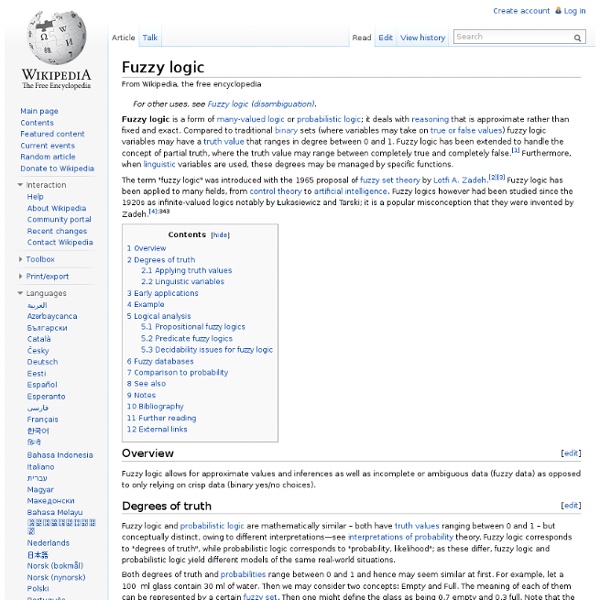Three-valued logic
In logic, a three-valued logic (also trivalent, ternary, trinary logic, or trilean,[citation needed] sometimes abbreviated 3VL) is any of several many-valued logic systems in which there are three truth values indicating true, false and some indeterminate third value. This is contrasted with the more commonly known bivalent logics (such as classical sentential or Boolean logic) which provide only for true and false. Conceptual form and basic ideas were initially created by Jan Łukasiewicz and C. Representation of values[edit] As with bivalent logic, truth values in ternary logic may be represented numerically using various representations of the ternary numeral system. Inside a ternary computer, ternary values are represented by ternary signals. This article mainly illustrates a system of ternary propositional logic using the truth values {false, unknown, and true}, and extends conventional Boolean connectives to a trivalent context. Logics[edit] Kleene logic[edit] , and its truth table is
Gödel's incompleteness theorems
Gödel's incompleteness theorems are two theorems of mathematical logic that establish inherent limitations of all but the most trivial axiomatic systems capable of doing arithmetic. The theorems, proven by Kurt Gödel in 1931, are important both in mathematical logic and in the philosophy of mathematics. The two results are widely, but not universally, interpreted as showing that Hilbert's program to find a complete and consistent set of axioms for all mathematics is impossible, giving a negative answer to Hilbert's second problem. The first incompleteness theorem states that no consistent system of axioms whose theorems can be listed by an "effective procedure" (i.e., any sort of algorithm) is capable of proving all truths about the relations of the natural numbers (arithmetic). For any such system, there will always be statements about the natural numbers that are true, but that are unprovable within the system. Background[edit] First incompleteness theorem[edit] Diagonalization[edit] B.
Principle of explosion
The principle of explosion, (Latin: ex falso quodlibet, "from a falsehood, anything follows", or ex contradictione sequitur quodlibet, "from a contradiction, anything follows") or the principle of Pseudo-Scotus, is the law of classical logic, intuitionistic logic and similar logical systems, according to which any statement can be proven from a contradiction.[1] That is, once a contradiction has been asserted, any proposition (or its negation) can be inferred from it. As a demonstration of the principle, consider two contradictory statements - “All lemons are yellow” and "Not all lemons are yellow", and suppose (for the sake of argument) that both are simultaneously true. If that is the case, anything can be proven, e.g. "Santa Claus exists", by using the following argument: Symbolic representation[edit] The principle of explosion can be expressed in the following way (where " " symbolizes the relation of logical consequence): or This can be read as, "If one claims something is both true ( .
Ignoratio elenchi
Ignoratio elenchi, also known as irrelevant conclusion,[1] is the informal fallacy of presenting an argument that may or may not be logically valid, but fails nonetheless to address the issue in question. Ignoratio elenchi falls into the broad class of relevance fallacies.[2] It is one of the fallacies identified by Aristotle in his Organon. In a broader sense he asserted that all fallacies are a form of ignoratio elenchi.[3][4] Ignoratio Elenchi, according to Aristotle, is a fallacy which arises from “ignorance of the nature of refutation.” The phrase ignoratio elenchi is Latin meaning "an ignoring of a refutation". An example might be a situation where A and B are debating whether the law permits A to do something. See also[edit] References[edit] External links[edit]



